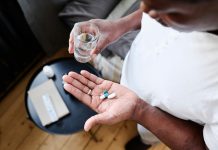
In a new study, researchers found that endurance exercise, such as running, swimming, cross-country skiing, and cycling, could help people age better than resistance exercise, which involves strength training with weights.
The researchers at Leipzig University looked at the effects of three types of exercise—endurance training, high-intensity interval training, and resistance training—on the way cells in the human body age.
They found that endurance and high-intensity training both slowed or even reversed cellular aging, but that resistance training did not.
Our DNA is organized into chromosomes in all the cells in our bodies.
At the end of each chromosome is a repetitive DNA sequence, called a telomere, that caps the chromosome and protects its ends from deteriorating.
As we grow older, the telomeres shorten and this is an important molecular mechanism for cell aging.
Aging eventually leads to cell death when the telomere is no longer able to protect the chromosomal DNA. The process of telomere shortening is regulated by several proteins.
Among them is the enzyme telomerase that is able to counteract the shortening process and can even add length to the telomeres.
The study enrolled 266 young, healthy but previously inactive volunteers and randomized them to six months of endurance training (continuous running), high-intensity interval training, resistance training, or to an unchanged lifestyle (the control group).
The high-intensity interval training included warm-up, followed by four bouts of high intensity running alternating with slower running, and then a final cool down of slower running.
The resistance training was circuit training on eight machines, including back extension, crunch, pulldown, seated rowing, seated leg curl and extension, seated chest press and lying leg press.
The participants who took the three forms of exercise undertook three 45-minutes sessions a week, and a total of 124 completed the study.
The team analyzed telomere length and telomerase activity in white blood cells in blood taken from the volunteers at the start of the study, and two to seven days after the final bout of exercise six months later.
Their main finding is that, compared to the start of the study and the control group, in volunteers who did endurance and high-intensity training, telomerase activity and telomere length increased, which are both important for cellular aging, regenerative capacity and thus, healthy aging. Interestingly, resistance training did not exert these effects.
Telomerase activity was increased two- to three-fold and telomere length was increased significantly in the endurance and high-intensity training groups compared to the resistance and control groups.
The study identifies a mechanism by which endurance training—but not resistance training—improves healthy aging.
It may help to design future studies on this important topic by using telomere length as an indicator of ‘biological age’ in future intervention studies.
Previous research has shown that longer telomeres and increased telomerase activity are associated with healthy aging.
But this is the first prospective, randomized controlled study of the effects of different forms of exercise on these two measurements of cellular aging.
A possible mechanism that might explain why endurance and high-intensity training could increase telomere length and telomerase activity is that these types of exercise affect levels of nitric oxide in the blood vessels, contributing to the changes in the cells.
From an evolutionary perspective, endurance and high-intensity training may mimic the advantageous traveling and fight or flight behavior of our ancestors better than strength training.
The researchers were led by Professor Ulrich Laufs, of Leipzig University, Germany.
The study is published in the European Heart Journal.
Copyright © 2019 Knowridge Science Report. All rights reserved.



